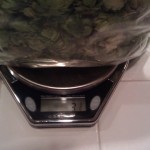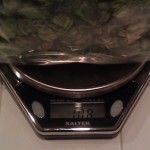What do you do when you have nearly a pound of fresh, homegrown whole hop cones in your possession? Well, you try to figure out how to brew with them.
These photos are of one of the bags at weigh in. I have three more just like it and more on the way:
I have brewed several beers with the hops I have grown in my back yard, both ales and lagers. This year, I am going to try to brew a well hopped lager with a simple grain bill.
I am trying to showcase the hops this time around. Since my harvest consists of German-like varieties (with a USA twist!), the idea of a Sam Adams Boston Lager clone came to mind. If this beer turns out the way I think it will, it should be hoppier than what you can get in stores. A good portion of the cones will be used in a dry hopping, which I hope will bring out the aroma in the lager.
Ingredients:
10 lbs Pale Ale Malt
1 lbs 2-Row Caramel Malt 60°L
1 oz Magnum hops (%AA unknown) boiled 60 mins.
1 oz Mt. Hood hops (%AA unknown)boiled 30 mins.
1 oz Mt. Hood hops (%AA unknown) boiled 10 mins.
1 oz Mt. Hood hops (%AA unknown) boiled 1 mins.
3 oz Mt. Hood hops (%AA unknown) dry hopped
Yeast :White Labs WLP830 German Lager
Predictions:
Original Gravity: 1.054
Terminal Gravity: 1.013
Color: 13.68 °SRM
Bitterness: No idea
Alcohol % by volume: 5.4%
Instructions:
Mash grains at 150°F for 60 minutes. Sparge and collect enough wort for a starting volume of 7.5 gallons. Those whole hop cones are going to absorb a lot of wort as the boil goes on so you will need to get as much as you kettle can handle. Watch for boilovers, naturally. Add the hops according to the schedule. Chill to 44°F and pitch your mighty yeast starter. Let the fermenter rise in temperature to 50° F and hold the beer there for at least two weeks. During that time, you will want to check on the fermentation activity. Once it is about to slow, add your hops for dry hopping. When fermentation activity appears to be done, take a gravity reading to ensure terminal gravity has been reached. Once that happens, rack to a clean carboy for some cold conditioning at refrigerator temperatures for a least a month. Bottle or keg as usual after the conditioning phase is over.
I will be brewing this soon since I want it to be done before Thanksgiving. Watch for updates and brew on.



Leave a Reply